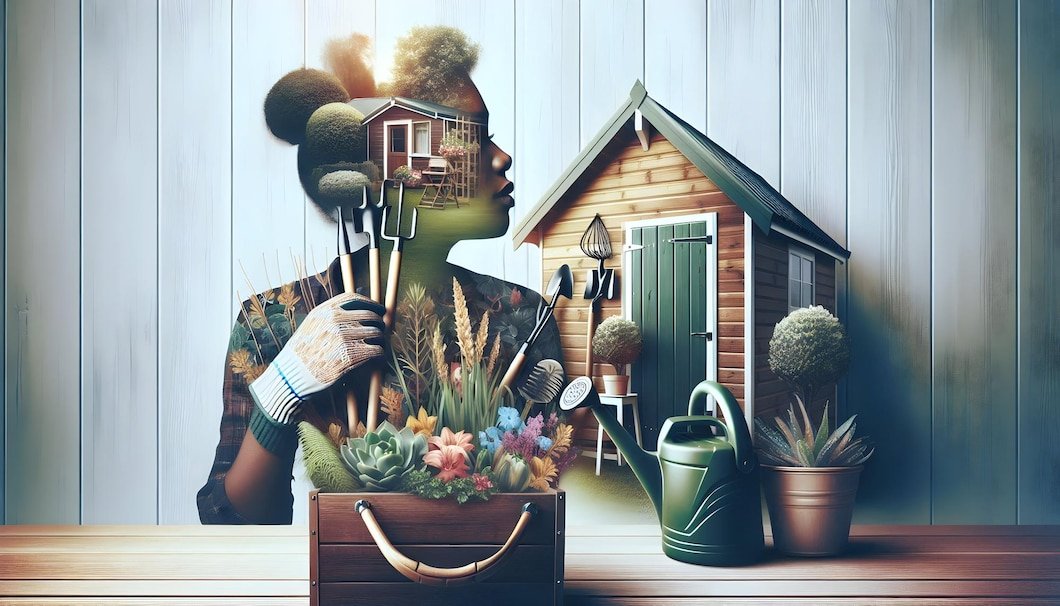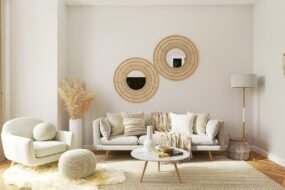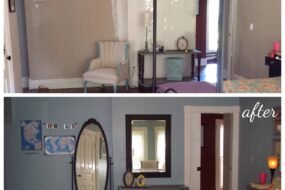
In today’s fast-paced world, many of us are constantly looking for ways to express our creativity and personalize our living spaces. DIY projects are a fantastic outlet for those who want to bring their vision to life without relying on professional help or spending a fortune on expensive decor. Whether you’re looking to refresh a room, organize your clutter, or add unique touches to your home, DIY projects offer endless possibilities for self-expression and creativity.
The best part? You don’t need to be an expert or have a lot of experience to start creating. With the right inspiration and a few materials, anyone can embark on a DIY adventure and transform their space into something truly special. In this post, we’ll share a variety of creative DIY ideas that will spark your imagination and help you transform your home with simple, affordable projects.
1. Create a Statement Wall with Peel-and-Stick Wallpaper
One of the easiest and most impactful ways to add character to a room is by creating a statement wall. Peel-and-stick wallpaper is a perfect option for those who want to experiment with bold designs without the permanence of traditional wallpaper. From floral patterns to geometric shapes, the choices are endless, and it’s an easy way to bring texture and color to your space.
Materials Needed:
- Peel-and-stick wallpaper (choose a pattern or color you love)
- Measuring tape
- Utility knife
- Scissors
- Smoothing tool or wallpaper brush
Instructions:
- Choose Your Wall: Pick a wall that you want to highlight. This could be the wall behind your bed, your living room sofa, or any wall that you want to make a focal point.
- Prepare the Surface: Clean the wall thoroughly to remove any dirt, dust, or grease. A smooth, clean surface is key for the wallpaper to stick properly.
- Measure and Cut: Measure the height and width of the wall and cut the wallpaper to size. If your wall is wider than the wallpaper’s roll, you’ll need to measure and cut accordingly for each section.
- Apply the Wallpaper: Start at the top of the wall and peel off the backing as you apply the wallpaper, smoothing it out with the brush or smoothing tool. Work slowly and make sure to press out any air bubbles.
- Trim Edges: Once you’ve applied the wallpaper, trim any excess with a utility knife to create clean edges.
Peel-and-stick wallpaper is a perfect DIY project for renters or anyone looking for a temporary yet stunning update to their space. It’s quick, easy, and can be done in a weekend!
2. Upcycle Old Furniture with Paint and New Hardware
If you have old, tired furniture taking up space, why not give it a second life with a fresh coat of paint and some new hardware? This simple DIY project can completely transform a piece of furniture, whether it’s a vintage dresser, nightstand, or kitchen table. With just a little time and effort, you can turn something old into something new and stylish.
Materials Needed:
- Chalk or furniture paint (choose a color that complements your space)
- Paintbrushes or a roller
- Sandpaper or sanding block
- New hardware (drawer pulls, knobs)
- Painter’s tape (optional)
Instructions:
- Prepare the Furniture: Start by cleaning your furniture to remove any dust, dirt, or grease. If the piece is shiny, lightly sand it to help the paint adhere better.
- Tape Off Areas: If you want to protect parts of the furniture (such as the edges or any decorative trim), use painter’s tape to mask off these areas.
- Apply the Paint: Use your paintbrush or roller to apply a thin, even coat of paint to the surface. Allow it to dry, and apply a second or third coat as needed.
- Replace the Hardware: Once the paint is dry, swap out the old hardware for new knobs or drawer pulls. This small change can completely alter the look of the piece.
- Seal the Finish: For added durability, consider sealing the paint with a clear topcoat, especially if the furniture will be used frequently.
This DIY project is ideal for beginners and can breathe new life into your furniture without the need for expensive replacements. Plus, it’s an eco-friendly option that helps reduce waste!
3. Create a Customized Gallery Wall
A gallery wall is a fun and creative way to showcase your personal style and create a focal point in any room. Whether you love photography, artwork, or a mix of both, a gallery wall allows you to curate a collection of pieces that speak to your taste. The best part? You can change the layout and contents as often as you like, giving you endless opportunities for creativity.
Materials Needed:
- Frames of various sizes
- Artwork, photos, or prints
- Picture hanging tools (nails, hooks, or adhesive strips)
- Level or measuring tape
Instructions:
- Select Your Artwork: Choose a mix of artwork, prints, or photos that reflect your personality. You can buy prints or create your own using DIY art techniques like watercolor or digital art.
- Choose a Wall: Pick a wall to feature your gallery. It could be above a sofa, in a hallway, or in your home office.
- Arrange the Frames: Before hanging anything, lay out your frames on the floor to experiment with different arrangements. You can go for a grid pattern or a more organic, freeform look.
- Hang the Frames: Once you’ve settled on a layout, use picture hooks or nails to hang the frames on the wall. Use a level to ensure the frames are straight and evenly spaced.
- Personalize and Enjoy: Add personal touches such as inspirational quotes, photographs of loved ones, or abstract art that inspires you. The gallery wall is your canvas, and it’s the perfect opportunity to mix and match different styles and mediums.
Creating a gallery wall is an easy way to personalize any room and showcase your unique style. It’s a DIY project that allows for plenty of creativity and customization.
4. Build a Floating Shelf for Extra Storage
Floating shelves are not only functional but also add a sleek, modern look to your space. They are perfect for displaying decorative items, storing books, or organizing everyday essentials. Building your own floating shelves is surprisingly simple, even for beginners, and they can be customized to fit any space.
Materials Needed:
- Wood planks
- Floating shelf brackets or hardware
- Screws and a drill
- Sandpaper
- Paint or stain (optional)
Instructions:
- Measure the Space: Decide where you want to install your floating shelf. Measure the width and height of the area to ensure the shelf will fit properly.
- Cut the Wood: If necessary, cut the wood plank to your desired shelf length. Sand the edges and surface for a smooth finish.
- Install the Brackets: Depending on the type of floating shelf hardware you use, install the brackets on the wall where the shelf will go. Use a level to ensure the brackets are straight.
- Attach the Shelf: Once the brackets are in place, attach the shelf to the brackets, ensuring it is secure.
- Finishing Touches: If you’d like, paint or stain the shelf to match the decor of the room.
Floating shelves are a fantastic DIY project for maximizing storage while maintaining a clean, modern look. You can create them in any size or style to fit your space perfectly.
5. DIY Fabric Wall Art for a Soft, Cozy Touch
Fabric wall art is an easy way to add texture, color, and a personal touch to your walls. Unlike traditional framed art, fabric wall hangings are soft, lightweight, and can be custom-designed to match your home’s color scheme. This project is perfect for beginners and can be completed in just a few hours.
Materials Needed:
- Fabric of your choice (cotton, linen, or canvas works well)
- Wooden dowel or curtain rod
- Hot glue gun
- Scissors
- String or twine (for hanging)
Instructions:
- Choose the Fabric: Select a fabric that complements your room’s decor. You can choose a pattern or a solid color, depending on your style.
- Cut the Fabric: Cut the fabric to the desired size, leaving a few extra inches at the top to create a pocket for the dowel.
- Attach the Dowel: Fold the top edge of the fabric over the dowel and use a hot glue gun to secure it. This will create a pocket where the dowel can slide through.
- Hang the Fabric: Once the glue has dried, thread a piece of twine through the dowel, and hang the fabric art on your wall.
- Personalize (Optional): You can add embellishments such as tassels, fringe, or embroidery to give the fabric art a more personalized touch.
Fabric wall art is a simple and inexpensive way to add visual interest and softness to your space. Plus, it’s an easy DIY project that can be customized to fit any room in your home.
6. Make Your Own Macramé Plant Hangers
Macramé plant hangers are a wonderful way to bring a touch of boho charm to your home. These handmade hangers are perfect for showcasing your favorite plants and add a cozy, natural element to any room. If you’re new to macramé, don’t worry—this project is beginner-friendly and incredibly rewarding.
Materials Needed:
- Macramé cord
- Wooden rings or dowels
- Scissors
- Plant pots and plants
Instructions:
- Cut the Cord: Cut several lengths of macramé cord, each about 6-8 feet long. The number of cords will depend on the design you choose.
- Create a Knotting Pattern: Learn a basic macramé knotting technique, such as the square knot or spiral knot. Start by tying the cords around the wooden ring to create the base.
- Knot the Hanger: Continue knotting the cords in a pattern that suits your style, ensuring there’s enough length to hold the plant pot securely.
- Finish the Bottom: Once the hanger reaches the desired length, knot the cords at the bottom to form a secure “basket” for your plant pot.
- Hang and Display: Place your plants in the hangers and hang them from hooks or ceiling mounts.
Macramé plant hangers add a bohemian flair to your home and are a great way to showcase your indoor plants in style.
7. Revamp Your Space with a DIY Rug
Creating a custom rug is a fun way to add warmth and color to your home. You can make a rug from old fabrics or by painting a simple pattern on a plain rug. It’s a creative project that allows you to personalize the rug to match your space’s theme.
Materials Needed:
- Plain rug or canvas fabric
- Fabric paint or dye
- Stencils or painter’s tape (optional)
- Brushes or sponges
Instructions:
- Select the Rug: Start with a plain, neutral-colored rug or canvas fabric that will serve as your base.
- Design the Pattern: Plan out the design you want for your rug. You can use stencils, painter’s tape, or freehand painting to create geometric patterns, stripes, or even a more intricate design.
- Paint the Rug: Use fabric paint or dye to apply your design to the rug. Make sure to follow the instructions on the paint or dye for the best results.
- Let Dry and Set: Allow the rug to dry completely before using it. If you used fabric paint, make sure to set the paint by ironing it, as instructed.
A custom DIY rug adds personality to any room and is a perfect way to showcase your creativity.
Conclusion
DIY home projects offer a wonderful opportunity to express your creativity and transform your living space in ways that reflect your unique style. Whether you’re updating your furniture, creating a personalized wall display, or experimenting with fabric and paint, there are endless possibilities for imaginative DIY projects. Best of all, these projects don’t require professional experience or huge budgets, making them perfect for beginners and experienced DIY enthusiasts alike.
So, grab your tools, unleash your imagination, and start creating! With a little effort and some creative inspiration, you can turn your home into a place that truly feels like yours.








